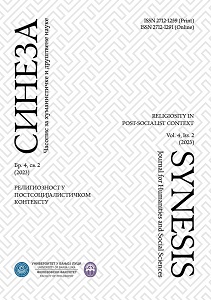Cult of Saint Sava and preservation of identity of Serbs in Bosnia during Ottoman and Austro-Hungarian administrations
Cult of Saint Sava and preservation of identity of Serbs in Bosnia during Ottoman and Austro-Hungarian administrations
Author(s): Boško M. BrankovićSubject(s): Ethnohistory, Eastern Orthodoxy, Sociology of Religion, Identity of Collectives
Published by: Filozofski fakultet, Univerzitet u Banjoj Luci
Keywords: Serbs; Bosnia; cult of Saint Sava; Orthodox faith; Serbian church;
Summary/Abstract: The paper will elaborate on the cult of Saint Sava and its scope in Bosnia during the Ottoman and Austro-Hungarian administrations. The cult of Saint Sava was widely spread among the Serbian people in Bosnia during the Ottoman and Austro-Hungarian administrations. Such a great influence of the cult of Saint Sava in Bosnia is not accidental, if one takes into account the number of Serbian Orthodox people in Bosnia at that time. The affiliation of Serbs to the Orthodox faith and the Serbian Orthodox Church in Bosnia is unquestionable throughout history, and national and religious affiliations were especially expressed during the Ottoman and Austro-Hungarian administrations and the struggle to preserve national and religious identity. Migrations of the Serbian people also contributed to the spread of the cult to a significant extent, and wherever they migrated during the centuries of foreign rule, they carried with them the memory of the holy lineage of the Nemanjić dynasty, and the cult of Saint Sava, which at the beginning spread as a church cult, and later as a people’s cult. Therefore, it can be concluded that during the period of foreign rule, Ottoman and Austro-Hungarian, there was no person in Bosnia who did not know about the medieval dynasty of Nemanjić and Saint Sava.
Journal: Sineza
- Issue Year: 4/2023
- Issue No: 2
- Page Range: 71-81
- Page Count: 11
- Language: English

